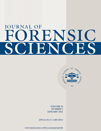Quantitative MRI in Isotropic Spatial Resolution for Forensic Soft Tissue Documentation. Why and How?*
Supported by a grant of the Swedish Knowledge Foundation (KK-stiftelsen 2007/0170), a grant of the Swiss National Science Foundation (PBBE33-115060), and a grant of the Swedish National Board of Forensic Medicine (RMV) (all to Dr. Jackowski).
Abstract
Abstract: A quantification of T1, T2, and PD in high isotropic resolution was performed on corpses. Isotropic and quantified postmortem magnetic resonance (IQpmMR) enables sophisticated 3D postprocessing, such as reformatting and volume rendering. The body tissues can be characterized by the combination of these three values. The values of T1, T2, and PD were given as coordinates in a T1–T2–PD space where similar tissue voxels formed clusters. Implementing in a volume rendering software enabled color encoding of specific tissues and pathologies in 3D models of the corpse similar to computed tomography, but with distinctively more powerful soft tissue discrimination. From IQpmMR data, any image plane at any contrast weighting may be calculated or 3D color-encoded volume rendering may be carried out. The introduced approach will enable future computer-aided diagnosis that, e.g., checks corpses for a hemorrhage distribution based on the knowledge of its T1–T2–PD vector behavior in a high spatial resolution.




